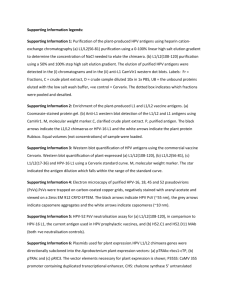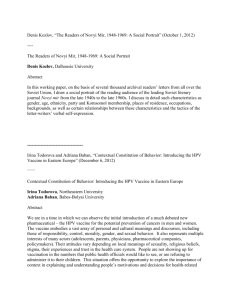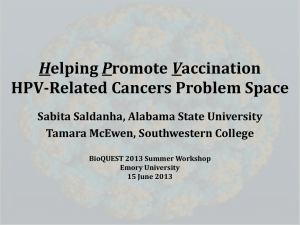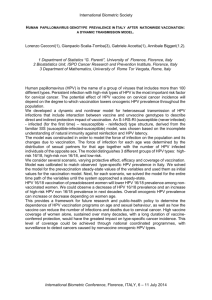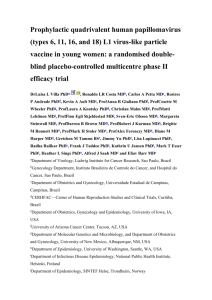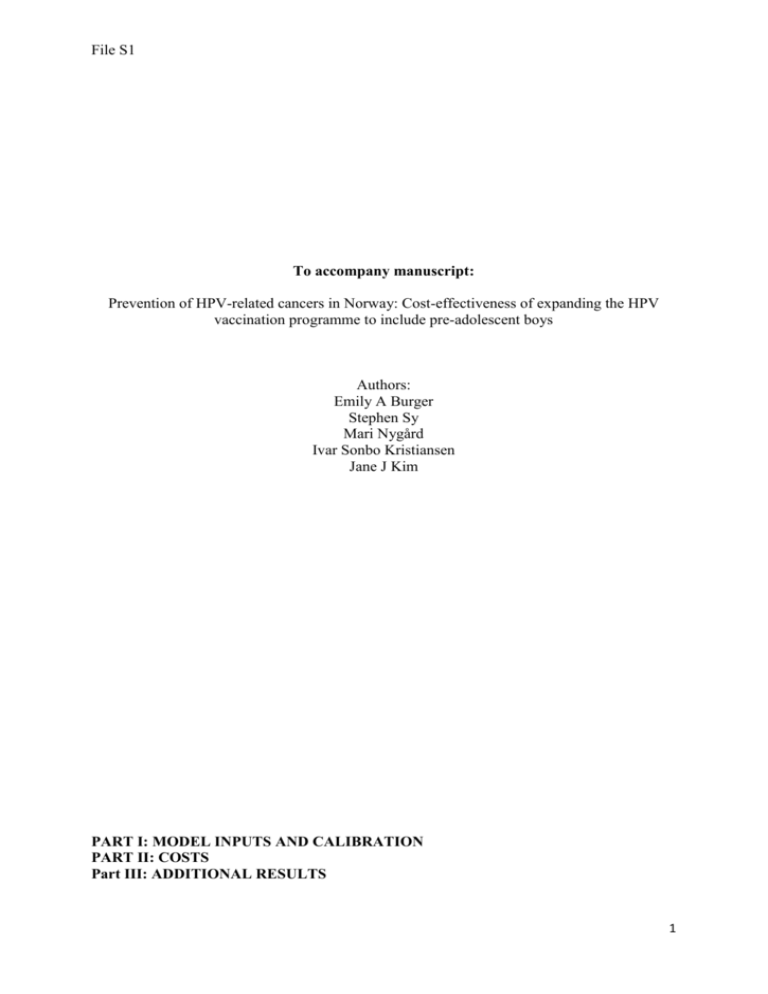
File S1
To accompany manuscript:
Prevention of HPV-related cancers in Norway: Cost-effectiveness of expanding the HPV
vaccination programme to include pre-adolescent boys
Authors:
Emily A Burger
Stephen Sy
Mari Nygård
Ivar Sonbo Kristiansen
Jane J Kim
PART I: MODEL INPUTS AND CALIBRATION
PART II: COSTS
Part III: ADDITIONAL RESULTS
1
File S1
PART I: MODEL INPUTS AND CALIBRATION
Models
We adapted a dynamic model of human papillomavirus (HPV)-16 and -18 transmission1;2 to
simulate sexual behavior between heterosexual males and females in Norway. We
incorporated new information on the transmission dynamics and natural history of HPV in
men. For example, we assumed that compared to women, men do not develop the same level
of natural immunity following the first HPV infection and clearance.3 In addition, the
probability of a female-to-male transmission is believed to be greater than the converse due to
higher viral load in the cervix compared to the male genitals.4 Assumptions and inputs to the
dynamic model are discussed in greater detail below.
We used a stochastic disease model, to simulate HPV-induced cervical cancer in the context
of the current Norwegian screening program. Initial parameters for both models were based
on data from epidemiological and demographic studies and calibrated using a likelihoodbased method to fit empirical outcomes, such as HPV prevalence, HPV type distribution and
pre-screening cervical cancer incidence, observed in Norway. For all other non-cervical HPVrelated conditions, we used an incidence-based modeling approach to capture the health and
economic burdens for both genders.
Epidemiological inputs
Inputs such as age-specific fertility rates and population statistics were elicited from Statistics
Norway (Table S1).5
Table S1. Population (and fertility rates), by sex and age, 2011
0-4 years
5-9 years
10-14 years
15-19 years
20-24 years
25-29 years
30-34 years
35-39 years
40-44 years
45-49 years
50-54 years
55-59 years
60-64 years
65-69 years
70-74 years
75-79 years
80-84 years
85-89 years
90-94 years
95-99 years
Females
Males
151,104
147,344
152,033
157,162
162,243
157,834
159,003
170,840
181,858
170,066
157,553
150,838
141,462
125,538
88,034
72,174
64,041
48,159
23,604
5,492
159,663
153,725
159,706
167,828
168,352
164,358
166,836
180,495
191,792
181,291
165,360
154,425
144,685
123,568
79,090
58,027
43,877
25,565
8,781
1,328
Fertility rate,
Annual per woman (2011)
---0.0071
0.0543
0.1207
0.1239
0.0578
0.0109
0.0006
-----------
Sexual behavior
We defined the level of sexual activity (number of partners in the previous 12 months) by four
sexual activity groups (SAGs): None (0 partners), Low (1-2 partners), Moderate (3-4 partners)
and High (5 or more partners). A study on sexual behavior among Norwegian adolescents
2
File S1
aged 13-196 and individual level data from the 2002 Norwegian population survey for ages
18-497 were used to derive age-specific proportions in each SAG (Table S2).
Table S2. Proportion of females and males in each sexual activity group, by age
Age
Females
13-14 yrs
15-17 yrs
18-19 yrs
20-24 yrs
25-29 yrs
30-34 yrs
35-39 yrs
40-49 yrs
Males
13-14 yrs
15-17 yrs
18-19 yrs
20-24 yrs
25-29 yrs
30-34 yrs
35-39 yrs
40-49 yrs
None
Low 1-2
Moderate 3-4
High 5+
0.8400
0.5633
0.3056
0.1149
0.0558
0.0609
0.0571
0.0825
0.0800
0.3267
0.4861
0.7368
0.8290
0.8631
0.8810
0.8686
0.0800
0.0800
0.1250
0.0861
0.0855
0.0532
0.0476
0.0412
0.0000
0.0300
0.0833
0.0622
0.0297
0.0228
0.0143
0.0077
0.7600
0.6700
0.3684
0.1843
0.0711
0.0808
0.0710
0.0995
0.1600
0.2200
0.4386
0.5877
0.7396
0.7828
0.8258
0.8094
0.0800
0.0800
0.0877
0.1754
0.1420
0.0657
0.0516
0.0552
0.0000
0.0300
0.1053
0.0526
0.0473
0.0707
0.0516
0.0359
For the youngest age groups, only data on the proportion of sexual debut were available
(could not define SAGs or number of partnerships); therefore, we elected to distribute the
proportion of sexually active13-14 year old females evenly among the low and moderate
SAGs. For males, we held the proportion in the moderate SAG equal to females and
distributed the remaining in the low SAG. We tested this assumption during model calibration and
it was found to achieve the best model fit. We assumed one and two new partnerships per year for
the female SAGs low and moderate, respectively. Gender, SAG and age-specific rates of new
partnership acquisition were set as reported by the women; male rates were then adjusted to
equalize and balance partnerships (essentially adjusting reported male new partnerships by
0.94). After adjustments and assumptions, the average number of lifetime partners came to
approximately 8.06 and the empirical data from Norway (ages 18-49)7 estimates the number
at 7.68 (standard deviation: 2.34) and 10.59 (standard deviation: 14) for females and males,
respectively (Table S3). We assumed moderately assortative mixing by both age and by SAG
using a mixing coefficient of 0.5 on a 0 to 1 scale (0 is equivalent to partnerships only formed
with individuals from the same age or SAG; 1 is equivalent to partnerships formed at
random). This assumption was also tested during calibration and found to achieve the best fit to
Norwegian empirical data for age-specific HPV16 and HPV18 prevalence.
Table S3. Mean number of new partnerships from the opposite sex, in the last 12 months
Age
None Low, 1-2
Moderate, 3-4
Females (number of male partners)
10-14 yrs 0.00
1.00
2.00
15-19 yrs 0.00
1.08
2.53
20-24 yrs 0.00
2.12
4.34
25-29 yrs 0.00
0.81
3.26
30-34 yrs 0.00
0.56
3.07
35-39 yrs 0.00
0.46
3.30
40-49 yrs 0.00
0.41
3.06
45-49 yrs 0.00
0.41
3.06
Males (number of female partners)
High, 5+
0.00
6.00
7.31
10.00
8.80
5.00
7.33
7.33
3
File S1
10-14 yrs
15-19 yrs
20-24 yrs
25-29 yrs
30-34 yrs
35-39 yrs
40-44 yrs
45-49 yrs
0.00
0.00
0.00
0.00
0.00
0.00
0.00
0.00
0.94
1.10
1.06
0.89
0.56
0.46
0.35
0.35
1.89
2.42
3.21
3.15
2.62
3.19
3.12
3.12
0.00
5.54
5.82
6.26
8.50
6.61
6.83
6.83
The model does not explicitly account for men who have sex with men (MSM), and may
overestimate herd immunity benefits. However, some herd immunity benefits will still be
experienced among those with bisexual tendencies. Norwegian sexual behaviour data suggest
that the proportion of MSM ranges from 0.6-2.8% (depending on age) while more individuals
identify with bisexual behaviour compared to exclusively being homosexual, particularly
prior to age 30, when the majority of HPV transmission takes place (Table S4).7
Table S4. Distribution of sexual orientation, by gender and age
Heterosexual
Females
18-19
20-24
25-29
30-34
35-39
40-49
Males
18-19
20-24
25-29
30-34
35-39
40-49
Heterosexual
with
homosexual
tendencies
Homosexual
with
heterosexual
tendencies
Not
sure
Homosexual
Bisexual
Total
84.6%
88.4%
94.7%
94.5%
96.0%
96.1%
0.0%
0.7%
0.6%
0.3%
0.7%
0.5%
7.7%
2.4%
0.8%
0.6%
1.3%
0.5%
6.6%
6.5%
3.4%
3.8%
1.3%
1.8%
0.0%
0.3%
0.0%
0.0%
0.0%
0.0%
1.1%
1.7%
0.6%
0.8%
0.7%
1.1%
100.0%
100.0%
100.0%
100.0%
100.0%
100.0%
86.1%
89.5%
93.1%
96.4%
94.1%
91.7%
2.8%
0.6%
1.5%
1.6%
1.5%
2.3%
0.0%
1.9%
0.5%
0.0%
0.0%
1.1%
9.7%
5.6%
3.9%
1.2%
3.5%
2.5%
0.0%
1.2%
0.0%
0.4%
0.5%
0.6%
1.4%
1.2%
1.0%
0.4%
0.5%
1.7%
100.0%
100.0%
100.0%
100.0%
100.0%
100.0%
Dynamic model calibration
The dynamic model calibration has been described previously.1;2 Briefly, for Norway, we
calibrated 1) type-specific transmission probability of HPV per infected-susceptible
partnership, 2) clearance rate of HPV, and 3) progression rate of a high-grade lesion to cancer.
For HPV clearance rates we used baseline gender and type-specific regression probabilities
from the published literature.8;9 To capture the lower transmission probability from male-tofemales compared to female-to-males,4 we estimated the relative risk (RR) of male-to-female
transmission using Hernandez et al 2008;10 selecting “any genital” and “cervix/urine” as the
sub-sites, and rounding to the nearest tenth. We applied the RR to the female-to-male
transmission probability. Female type-specific natural immunity following clearance of first
infection was estimated from the calibrated stochastic cervical cancer disease model11 and
used as an input value in the dynamic model resulting in natural immunity parameters of 0.88
and 0.87 for HPV-16 and -18, respectively. We assumed men do not mount the same level of
natural immunity as women3 (i.e., male-specific natural immunity of 11% after first infection,
for both HPV-16 and -18).
We generated a repository of 100,000 models runs, each using unique parameter values
selected from a uniform distribution over the specified ranges. Model outcomes associated
4
File S1
with each parameter set were scored according to their fit using a computed composite
goodness-of-fit score (summed over the log-likelihood measures of all targets). A cut-off
value, equal to the number of targets, was used to determine statistically indistinguishable sets
(n=3,160). For the base case analysis, we selected the parameter set that was closest the mean
value across all 3,160 “good-fitting” sets (Table S5).
Table S5. Calibrated parameter values
Variable
Baseline probabilitya
Search range
1. Transmission probability per infected-susceptible partnership
Female-to-male
HPV-16
0.5
0.5-1.0
HPV-18
0.5
0.5-1.0
Male-to-female
HPV-16
=Female HPV-16 *0.8
=Female HPV-16 *0.8
HPV-18
=Female HPV-18 *0.8
=Female HPV-18 *0.8
2. HPV clearance
Female8
HPV-16
0.2620
0-2b
HPV-18
0.4099
0-2b
Male9
HPV-16
0.4928
0-2b
HPV-18
0.7176
0-2b
3. CIN 2, 3 to invasive
0.002-0.030c
0-2b
cancer (HPV-16, -18)
aBaseline
Mean values
from good-fitting
sets (n=3,160)
Selected
for
base case
0.839
0.830
0.832
0.836
0.671
0.664
0.666
0.6688
1.235
1.235
1.218
1.218
1.235
1.235
1.218
1.218
1.249
HPV: human papillomavirus, CIN: cervical intraepithelial neoplasia.
probabilities are annual probabilities.
represent factors that were multiplied by the baseline probability. cRange represents age-specific values.
1.1777
bValues
Stochastic Model calibration
A similar approach as used in the dynamic model was used to calibrate baseline inputs to
reflect the natural history of cervical cancer in Norway and has been described previously.11
In total, 37 Norwegian-specific calibration targets were defined, which included age-specific
prevalence of HPV-16, -18 in women, age-specific prevalence of cervical intraepithelial
neoplasia (CIN) 2/3, HPV-16, -18 and other high-risk HPV distributions in high-grade CIN,
HPV-16 and -18 distributions in cervical cancer and age-specific cancer incidence. For each
calibration target, we determined a point estimate and confidence interval, using populationbased sources. For the base case analysis, we used the mean across the 50 “good-fitting”
parameter sets.
Model calibration output
For the dynamic model, the black bars represent the bounds from the empirical data, grey bars
represents model output for five good-fitting sets, and the red diamonds represent the selected
parameter set (closest to the mean across all good-fitting sets) used for all analyses. Below is
the calibration output for HPV prevalence (Figure S1), cancer incidence (Figure S2) and HPVtype distribution in high-grade precancer and cancer from the stochastic model (Figure S3).
For female HPV-16 and -18 prevalence, we used Skjeldestad et al 200812 to informed the
bounds for the younger age groups (16-19 years old) and unpublished data (Mari Nygård,
MD, PhD, personal communication, Cancer Registry of Norway) to inform the bounds for
ages 18-49 years. We assumed study participants to be sexually active and used a weighted
average from two sexual behavior studies conducted in Norway6;7 to adjust for sexual debut in
the younger age groups (57% sexual debut for ages 15-19 years).
5
File S1
Figure S1. Age-specific prevalence of HPV among females from dynamic model
6
File S1
Figure S2. Annual incidence of HPV-16, -18 associated cervical cancer incidence (1953-1969) from
the dynamic model
Figure S3. HPV type distribution among females with high-grade precancer (CIN2,3) and invasive
cancer from the stochastic cervical cancer model (grey bars represent the top 50 good-fitting parameter
sets used in all analyses)
7
File S1
Inputs for non-cervical diseases
Diseases attributable to high-risk HPV-16 and -18
The dynamic model was used to estimate the gender and type-specific cumulative reductions
in HPV-16 and -18 incidences up to age 50, given vaccine efficacy reported in the literature
and inclusive of herd immunity benefits. The estimated cumulative reductions were used as
inputs into the incidence-based non-cervical cancer models (Figure S4). The incidence of each
of the non-cervical cancers, the proportion of cases attributable to vaccine-targeted HPV types
(attributable fraction), 5-year survival, disease-specific utility weights, the cost per case (see
PART II, below) and excess mortality served as primary inputs to the models. We multiplied
the cumulative reductions in HPV from the dynamic model by the attributable fraction for
each non-cervical cancer. To project the impact of vaccination, we ran the models both
without and with vaccination for each cohort in order to estimate the incremental costs and
QALYs associated with the strategies.
Figure S4. Model schematic for non-cervical cancers
We used data from the Cancer Registry of Norway to inform the expected age-specific cancer
incidence in the absence of vaccination and 5-year survival for each oncogenic condition
(main manuscript Table 1). The registry is based on a modified version of International
Classification of Disease, version 7 or version O (ICD-7/ICD-O).1 We defined oropharyngeal
cancer to include ICD codes C01, C09 and C10 (base of tongue, tonsils and oropharynx).
Data specific to Norway (or Northern Europe if Norwegian-specific data was not available)
from ICO Data Query System13 was used to inform the proportion of cases attributable to
vaccine-targeted HPV types (Table S6). The upper and lower attributable fractions were used
in the “optimistic” and “pessimistic” multi-way sensitivity analysis (see main manuscript
Methods). It should be noted that the attributable fraction and incidence of non-cervical
cancers are prone to misclassification. For example, for anal cancers (ICD-code C21), the
topographical "line" separating anal and rectal cancers is unclear. Squamous cell carcinomas
coded in rectum may be in fact anal cancers while adenocarcinomas in the anus are most
likely rectal cancers. To estimate the proportions in main manuscript Figure 1, HPV-16 and 18 associated cancers were defined as cancers at specific anatomic sites where HPV is
commonly found. We applied the attributable fractions of HPV-16 and -18 from main
manuscript Table 1 to the average number of new cases per year (2008-2010) from the Cancer
Registry of Norway.
1
This study uses data from the Cancer Registry of Norway. Interpretation and reporting of these data are the sole
responsibility of the authors and has not been subject to acceptance from the Cancer Registry.
8
File S1
Diseases attributable to low-risk HPV-6 and -11
To estimate the impact vaccination will have on genital warts, we utilized data on age- and
gender-specific incidence of genital warts from two Northern European countries and
calibrated the cumulative incidence of having at least one case of genital warts to Norwegian
self-reported cumulative risk of 9.5%.14 We used Swedish data derived from the national
prescription registry to inform younger ages (ages 10-44).15 These data included incident
cases adjusted to exclude reoccurrences within six month or one calendar year. In the UK, the
Health Protection Agency reported the incidence genital warts (new episodes) from England
2002-2011.16 We selected the data from 2011 for ages 45-65+, to supplement the data from
Sweden. After adjusting the reported genital wart incidence (essentially reducing the agespecific rate) to reflect the cumulative incidence reported in Norway,14 the remaining incident
cases reported were then assumed to be reoccurrences. For juvenile-onset respiratory
papillomatosis (RRP), we specified a model which captured 2011 age-specific fertility rates
(Table S1) per woman, obtained from Statistics Norway, and applied the Norwegian incidence
rate of RRP17 per live birth. The proportion of RRP attributable to low-risk HPV-6 and -11
was assumed to be 100% (Table S6) but varied in sensitivity analysis (80-100%). The impact
of vaccination herd immunity benefits on HPV-6 and -11 warts and RRP was assumed to be
proportional to that of HPV-18 estimated from the dynamic model. We estimated the
monetary costs associated with treating genital warts or RRP using Norwegian-specific
guidelines (See PART II, below).
Table S6. Summary of attributable fraction of vaccine-targeted HPV in non-cervical disease
Vaginal, mean (CI)
Vulva, mean (CI)
Penile, mean (CI)
Anal, mean (CI)
Oropharyngeal, mean (CI)
JoRRP
Warts
HPV 16
63% (45-79)
38% (32-44)
42% (23-63)
73% (70-77)
53% (41-63)
nr
nr
HPV 18
3% (0-15)
6% (3-10)
4% (0-20)
9% (7-12)
1% (0-6)
nr
nr
HPV 6/11
nr
nr
nr
nr
nr
100% (80-100)
90% (80-100)
Setting
Northern Europe13
Northern Europe13
Northern Europe13
Northern Europe13
Norway18
Multiple19
Multiple19
CI: 95% confidence interval, HPV: Human papillomavirus, JoRRP: Juvenile-onset recurrent respiratory papillomatosis, nr: not relevant.
Screening assumptions
All vaccination scenarios assumed screen-eligible women followed the current cervical cancer
screening algorithm according to published compliance rates (i.e., status quo)20 and costs11
(Table S7). Status quo screening involved primary cytology (Pap) testing every three years.
Women with a high-grade result are referred directly to colposcopy with biopsy and treated if
a high-grade lesion is confirmed. Women with atypical cells or a low-grade result are referred
to combination testing (HPV with cytology) six months after primary index test. Individuals
who are both HPV-positive and cytology-positive (i.e., atypical cells or worse) are referred to
colposcopy with biopsy, while women with an HPV-negative and mild cytology result are
returned to their normal screening schedule. Persistently HPV-positive and cytology-negative
women are referred to colposcopy biopsy while, if at any point, a woman returns an HPVpositive, cytology-positive result, she will be referred directly to colposcopy/biopsy. We
assumed that 65% of women attend screening every three years, 25% attend less frequently
than recommended (i.e., every 4-8 years) and 10% never attend. We also assumed compliance
after an abnormal result was imperfect, such that 35% do not comply within one year (but are
not assumed to be permanently lost to follow-up).
9
File S1
Table S7. Screening cost inputs
Conventional cytology
HPV DNA testing
Office visit, time & transport
Colposcopy with biopsy
High-grade precancer
Totala
$49
$62
$160
$337
$2,160
10
File S1
PART II: COSTS
HPV vaccine
In 2011, a pharmaceutical statistics company (Farmastat21), reported that 34,313,964
Norwegian Kroner (NOK) was spent on 76,220 doses of the HPV vaccine (098732 Gardasil
INJ 10X0.50MLSPR), resulting in a price of approximately NOK 450 per dose (≈$75). This
amount is exclusive of value added tax (VAT). Estimates from 2012 show a stable cost per
dose. To estimate administration costs, we assumed nurses travel between schools, use
approximately 15-20 minutes per student (≈37.5 students per day) and 60 minutes of travel
per day (personal communication). In Norway, non-specialty nurses earn approximately
NOK33,600 per month5 and approximately NOK 564,480 per year (including 40% fringe
costs). These estimates imply administration and supplies to be NOK 84 (≈$13.83) per dose.
This is in line with school-based administration estimates reported in the UK.22
Treatment cost estimates for non-cervical HPV-related conditions
Norwegian-specific treatment costs of non-cervical HPV-related diseases have not been
previously published; therefore, we estimated the direct medical costs for the diagnosis,
treatment and 5-year surveillance (discounted 4% per year) using a combination of primary
data from the National Patient Registry, national guidelines and clinical judgment. All cost
estimates used in the current analysis are shown in Table S8, while we present more detailed
estimation and rationales below using anal cancer and genital warts to exemplify our process.
Additional costing information may be obtained from the authors upon request. To estimate
costs associated treatment, we based costs on official national hospital-based DRG
reimbursement tariffs23 and physician fee schedules24 using official treatment guidelines,
where available.25 For each HPV condition we sought expert opinion from Norwegian
oncologists and clinicians to assist in quantifying resource use and outline the typical patient
care pathway. In addition, data from the 2011 National Patient Registry provided additional
insight on DRG utilization for each cancer specified by ICD codes. The diagnosis of all stages
consisted of an initial physician office visit, site-specific assessment, biopsy and examination
of the biopsy for pathology. Follow-up care for post treatment surveillance was cancerspecific, but generally assumed four follow-up visits the first year, followed by biannual and
annual visits for year two and years 3-5, respectively. Data from the Cancer Registry of
Norway26 informed the distribution of stage at detection to give the stage-weighted average
lifetime cost per case. The proportion of direct non-medical costs (transport) and patient time
for all non-cervical conditions (≈15%) was estimated from detailed cervical cancer costing
and applied to baseline direct medical costs for all other non-cervical HPV-related conditions.
Influential inputs were varied for each condition and we determined that uniformly applying
+/- 25% would generate reasonable upper and lower bounds for our cost estimates. The upper
and lower bounds for Norwegian direct medical treatment costs were either inclusive or
slightly lower than costing point estimates recently reported for HPV-related cancers in
Denmark (a 3-year hospital sector perspective exclusive of costs in the year before
diagnosis).27 Monetary costs were measured in 2010 NOK and converted to US dollars (US $)
using the average annual 2010 exchange rate (US $1=NOK6.05).28
11
File S1
Table S8. Summary of treatment costs for HPV-related diseases, direct medical and total costs
Cervix
High-grade precancer
Local
Regional
Distant
Vagina
Vulva
Penis
Anus
Oropharynx
JoRRP
Genital warts
Direct medical
Totala
LBa
UBa
$23,500
$41,100
$48,800
$22,900
$24,200
$15,200
$32,600
$42,600
$116,400
$350
$2,160
$25,800
$51,600
$59,600
$26,400
$27,900
$17,500
$37,500
$49,000
$133,800
$400
$19,300
$38,700
$44,700
$19,800
$20,900
$13,100
$28,100
$36,800
$100,400
$300
$32,200
$64,500
$74,500
$33,000
$34,800
$21,800
$46,900
$61,300
$167,300
$500
aIncusive
of direct and nondirect medical costs. Assumes an average of 15% (estimated from
the weighted average of cervical cancer treatment) additional costs due to nondirect medical
costs (such as transportation and patient time) for all non-cervical diseases. Lower bounds (LB)
and upper bounds (UB) estimated by taking 75% and 125% of the total cost estimate. ($1USD=
NOK6.05, 2010)
Example 1: Anal cancer treatment:
In developing stage-specific estimates for the average lifetime cost of anal cancer, treatment
strategies were based on new treatment recommendations set forth by the Norwegian
Gastrointestinal Cancer Group (NGICG) and KVIST,29 and expert opinion from Oslo
University Hospital, Ullevål (personal communication: Marianne G. Guren, MD, PhD).
Treatment costs of stage T1/T2 (N0) cancer consisted of the costs related to CT/MRI for dose
planning, inpatient care (consisting of five radiotherapy fractions plus one course of MiFu
chemotherapy), and outpatient care (consisting of 22 fractions of radiotherapy (total of
54GY=27 fr)). Treatment costs related to T3/T4 (N0/N+) consisted of 58GY (29 fractions)
plus two courses of MiFu. For T3/T4 (N0/N+) cancer we assumed two separate inpatient
stays for which patients received chemotherapy and ten fractions of radiotherapy. The
remaining fractions were delivered on an outpatient basis. We also assumed 18% of patients
were readmitted for toxicity and 13% had residual tumor and were treated surgically with
abdominoperineal resection.30 For all stages we applied the cost of weekly consultations
throughout the course of primary treatment. We estimated the direct medical average cost per
case to be NOK196,000 or approximately $32,600. Our cost estimates varied from $30,80034,100 (NOK186,000-206,000) when we assumed different baseline inputs (Figure S5).
Finally, to ensure sensitivity analysis captured all plausible ranges, we varied the base case
estimates by +/-25%, resulting in $24,300-40,500 (NOK147,000-245,000). To capture the
direct non-medical costs such as transportation to/from appointments and patient time, 15%
was added to baseline calculations resulting in a total direct medical and nonmedical cost of
$37,500 (NOK226,800). The lower and upper bounds, used in the “optimistic” and
“pessimistic” scenario analysis, equated to $28,100 and 46,900, respectively (NOK170,100283,500)).
12
File S1
Figure S5. Impact of influential parameters on the average direct medical cost of anal cancer
Example 2: Genital warts
Treatment algorithms reflecting local practice were elicited from experts at Oslo University
Hospital, Olafia Clinic (personal communication: Harald Moi, MD, PhD and Anne Olsen,
MD, PhD) and used in combination with recently published European guidelines31 to generate
estimates of the cost of an average case of genital warts. We assumed 25% reoccurred after
three months, 13% of the reoccurrences persisted in year two and 2% continued to persist into
year three. For the first case of warts, we assumed that 90% are treated with a solution or
cream (Podophyllotoxin 5g and to a lesser extent Imiquimod 5%), 8% received cryotherapy
plus Podophyllotoxin 5g, and 2% received laser treatment as first line therapy. For first time
reoccurrences, 40% received solution or cream (higher proportion receiving Imiquimod 5%),
30% received combination cryotherapy plus Podophyllotoxin 5g and 30% received laser
treatment. For the few cases persisting into year three, 20% received solution/cream (nearly
all receive Imiquimod 5%), 30% received cryotherapy plus Podophyllotoxin, and 50%
received laser therapy. We estimated that an average case of genital warts cost approximately
$350 (NOK 2099) (Figure S6Figure S6). After including 15% (for nondirect medical costs and
patient time), the total costs associated with an average case of genital warts came to $400
(NOK2410) with a lower bound of $300 (NOK1810) and an upper bound of $500
(NOK3010).
Figure S6. Impact of influential parameters on the average direct medical cost of an episode of genital
warts
13
File S1
Part III: Additional results
Table S9 shows the estimated annual number of cases of HPV-related cancers under base case assumptions for vaccine properties (see text of main
manuscript).
Table S9. Projected annual number of cases for various vaccination scenarios
Observed
number of
cases,
average
2008-2010
Cervixb
Vulva
Vagina
Anus, female
Oropharynx, female
Penis
Anus, male
Oropharynx, male
Total, both genders
Total, female
Total, male
Projected annual number of casesa
No
vaccination
Girls-only
vaccination
(71%)
Girls + boys
vaccination
(71%)
Girls-only
vaccination
(90%)
306
82
14
47
37
49
23
91
648
486
162
179
53
7
16
21
35
11
61
381
275
106
162
49
6
12
19
28
6
48
331
249
82
135
48
5
10
18
29
7
50
302
217
85
Girls-only
vaccination (90%),
no additional herd
immunity for boys
135
48
5
10
18
35
11
61
323
217
106
Difference
Girls + boys
vaccination
(71%) vs. girlsonly (71%)
17
3
1
3
2
6
5
13
51
26
25
Girls-only
vaccination
(90%) vs. girls
+ boys (71%)
27
2
0
2
1
-1
-1
-2
28
32
-4
Girls-only vaccination
(90%), no additional
herd immunity for boys
vs. girls + boys (71%)
27
2
0
2
1
-6
-5
-13
8
32
-25
aProjections
reflect the expected number of cases per year using expected cancer reductions for the last cohort included in this analysis. The reduction in non-cervical HPV related cancers due to
vaccination are assumed to be proportional to the reduction in cumulative risk of acquiring HPV prior to age 50 and multiplied by the disease-specific HPV-16, -18 attributable fractions. bProjected
reduction in risk of cervical cancer is estimated from the stochastic disease model and in the context of current cervical cancer screening compliance.
14
File S1
Table S10 shows the discounted incremental cost and QALY for each HPV-related cancer
associated with the base case analysis.
Table S10. Discounted incremental costs and QALYs
Vulva
Vaginal
Anal, female
Oropharyngeal, female
Cervical cancer
JoRRP
Warts, females
Penile
Anal, male
Oropharyngeal, male
Warts, males
Vaccine ($75/dose)
Total
ICER
No vaccine to girls only (71%)
Disc. incremental Disc. incremental
cost
QALYs
-$72
0.01947
-$16
0.00324
-$116
0.02706
-$80
0.01268
-$864
0.13902
-$3
0.00002
-$453
0.03015
-$21
0.02805
-$37
0.00565
-$138
0.03338
-$334
0.02177
$3,733
$1,600
0.32048
$4,992
Girls only (71%) to girls + boys (71%)
Disc. incremental Disc. incremental
cost
QALYs
-$6
0.00163
-$1
0.00027
-$10
0.00226
-$7
0.00106
-$149
0.02463
$0
0.00000
-$40
0.00267
-$11
0.00152
-$20
0.00280
-$76
0.00812
-$144
0.00945
$3,733
$3,269
0.05440
$60,085
Disc.: Discounted (4% per year), ICER: incremental cost-effectiveness ratio, JoRRP: Juvenile-onset recurrent respiratory
papillomatosis, QALY: Quality-adjusted life year
15
File S1
References
(1) Kim JJ, Goldie SJ. (2009) Cost effectiveness analysis of including boys in a human
papillomavirus vaccination programme in the United States. BMJ 339.
(2) Kim JJ, Goldie SJ. (2008) Health and economic implications of HPV vaccination in the
United States. New England Journal of Medicine 359: 821-832.
(3) Lu B, Viscidi RP, Wu Y, Lee JH, Nyitray AG, Villa LL et al. (2012) Prevalent Serum
Antibody Is Not a Marker of Immune Protection against Acquisition of Oncogenic
HPV16 in Men. Cancer Research 72: 676-685.
(4) Moscicki AB, Schiffman M, Burchell A, Albero G, Giuliano AR, Goodman MT et al.
(2012) Updating the Natural History of Human Papillomavirus and Anogenital Cancers.
Vaccine 30: F24-F33.
(5) Statistics Norway. Available: http://www.ssb.no/english/. Accessed 10 January 2012
(6) Pedersen W, Samuelsen SW. (2003) [New patterns of sexual behavior among
adolescents]. Journal of the Norwegian Medical Society (Tidsskrift for Den norske
legeforening) 21: 3006-3009.
(7) Træen B, Stigum H, Magnus P. (2003) [Report from the sexual behavior survey in 1987,
1992, 1997, 2002]. Norwegian Institute for Public Health, Division of Epidemiology.
(8) Insinga RP, Perez G, Wheeler CM, Koutsky LA, Garland SM, Leodolter S et al. (2011)
Incident Cervical HPV Infections in Young Women: Transition Probabilities for CIN and
Infection Clearance. Cancer Epidemiology Biomarkers & Prevention 20: 287-296.
(9) Giuliano AR, Lee JH, Fulp W, Villa LL, Lazcano E, Papenfuss MR et al. (2011)
Incidence and clearance of genital human papillomavirus infection in men (HIM): a
cohort study. Lancet 377: 932-940.
(10) Hernandez BY, Wilkens LR, Zhu X, Thompson P, McDuffie K, Shvetsov YB et al.
(2008) Transmission of human papillomavirus in heterosexual couples. Emerging
Infectious Diseases 14: 888-894.
(11) Burger EA, Ortendahl JD, Sy S, Kristiansen IS, Kim JJ. (2012) Cost-effectiveness of
cervical cancer screening with primary human papillomavirus testing in Norway. Br J
Cancer 106: 1571-1578.
(12) Skjeldestad FE, Mehta V, Sings HL, Ovreness T, Turpin J, Su L et al. (2008)
Seroprevalence and genital DNA prevalence of HPV types 6, 11, 16 and 18 in a cohort of
young Norwegian women: study design and cohort characteristics. Acta Obstetricia et
Gynecologica Scandinavica 87: 81-88.
16
File S1
(13) World Health Organization. ICO (Institut Català d'Oncologia). Information Centre on
Human Papilloma Virus (HPV) and Cervical Cancer: Data Query System. Available:
http://www.who.int/hpvcentre/en/. Accessed 15 November 2012.
(14) Kjaer SK, Tran TN, Sparen P, Tryggvadottir L, Munk C, Dasbach E et al. (2007) The
burden of genital warts: a study of nearly 70,000 women from the general female
population in the 4 Nordic countries. Journal of Infectious Diseases 196: 1447-1454.
(15) Leval A, Herweijer E, Arnheim-Dahlstrom L, Walum H, Frans E, Sparen P et al. (2012)
Incidence of Genital Warts in Sweden Before and After Quadrivalent Human
Papillomavirus Vaccine Availability. Journal of Infectious Diseases 206: 860-866.
(16) Health Protection Agency. Number & rates of anogenital warts diagnosed in England,
2002-2011.Available: www.hpa.org.uk/webc/HPAwebFile/HPAweb_C/1296688631209.
Accessed 11 January 2013.
(17) Omland T, Akre H, Vardal M, Brondbo K. (2012) Epidemiological aspects of recurrent
respiratory papillomatosis: A population-based study. Laryngoscope 122: 1595-1599.
(18) Mork J, Møller Br, Dahl T, Bray F. (2010) Time trends in pharyngeal cancer incidence in
Norway 19812005: a subsite analysis based on a reabstraction and recoding of
registered cases. Cancer Causes and Control 21: 1397-1405.
(19) Lacey CJN, Lowndes CM, Shah KV. (2006) Burden and management of non-cancerous
HPV-related conditions: HPV-6/11 disease. Vaccine 24: 35-41.
(20) Cancer Registry of Norway. (2012) [2009 Annual Report Population-based Screening
against Cervical Cancer]. Available: http://www.kreftregisteret.no/
(21) Farmastat AS. 2013. http://www.farmastat.no.
(22) Jit M, Chapman R, Hughes O, Choi YH. (2011) Comparing bivalent and quadrivalent
human papillomavirus vaccines: economic evaluation based on transmission model.
British Medical Journal 343.
(23) Norwegian Directorate of Health. [Activity-based funding 2010/2011]. Available:
http://www.helsedirektoratet.no/finansieringsordninger/regelverk_innsatsstyrt_finansierin
g__isf__2011_78057. Accessed 10 December 2010.
(24) Norwegian Medical Association. [Normal tariff for private general practice 2010-2011].
Available: http://www.legeforeningen.no/normaltariff/Fastlegetariff_2010.pdf. Accessed
1 November 2010.
(25) Oncolex: Encyclopedia for Diagnosing and Treating Cancer. http://www.oncolex.no.
(26) Cancer Registry of Norway: Institute of population-based cancer research.
http://www.kreftregisteret.no.
17
File S1
(27) Olsen J, Jorgensen TR, Kofoed K, Larsen HK. (2012) Incidence and cost of anal, penile,
vaginal and vulvar cancer in Denmark. Bmc Public Health 12.
(28) Federal Reserve. Historical Rates for the Norwegian Krone. Available:
http://www.federalreserve.gov/RELEASES/H10/Hist/dat00_no.htm. Accessed 13 June
2011.
(29) NGICG and KVIST. [Professional recommendations for treatment of anal cancer].
Available:
http://ngicg.no/ngicg/handlingsprogram/faglige_anbefalinger/content/filelist_d92e9f7e226a-4d54-8c2dbc4ea29fbfb9/1348047422069/faglige_anbefalinger_for_behandling_ved_analcancer_21
211.pdf. Accessed 30 June 2012.
(30) Bentzen AG, Guren MG, Wanderas EH, Frykholm G, Tveit KM, Wilsgaard T et al.
(2012) Chemoradiotherapy of Anal Carcinoma: Survival and Recurrence in an
Unselected National Cohort. International Journal of Radiation Oncology Biology
Physics 83: E173-E180.
(31) Lacey CJN, Woodhall SC, Wikstrom A, Ross J. (2013) 2012 European guideline for the
management of anogenital warts. Journal of the European Academy of Dermatology and
Venereology 27: e263-e270.
18


